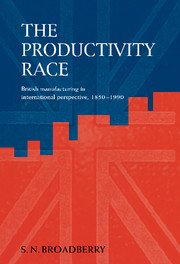Book contents
- Frontmatter
- Contents
- List of figures
- List of tables
- Acknowledgements
- Glossary of terms and company names
- 1 Introduction and overview
- Part 1 measuring comparative productivity performance
- 2 International comparisons of productivity in manufacturing: benchmark estimates by industry
- 3 Labour productivity in aggregate manufacturing: Britain, the United States and Germany
- 4 Extending the picture: manufacturing productivity in other industrialised countries
- 5 Manufacturing and the whole economy
- Part 2 explaining compartive productivity performence
- Part 3 reassessing the performance of British industry
- Bibliography
- Index
3 - Labour productivity in aggregate manufacturing: Britain, the United States and Germany
Published online by Cambridge University Press: 28 October 2009
- Frontmatter
- Contents
- List of figures
- List of tables
- Acknowledgements
- Glossary of terms and company names
- 1 Introduction and overview
- Part 1 measuring comparative productivity performance
- 2 International comparisons of productivity in manufacturing: benchmark estimates by industry
- 3 Labour productivity in aggregate manufacturing: Britain, the United States and Germany
- 4 Extending the picture: manufacturing productivity in other industrialised countries
- 5 Manufacturing and the whole economy
- Part 2 explaining compartive productivity performence
- Part 3 reassessing the performance of British industry
- Bibliography
- Index
Summary
Introduction
In chapter 2, we established comparative levels of labour productivity in benchmark years in a number of individual manufacturing industries for Britain, the United States and Germany. We also discussed the aggregation procedures used to establish the aggregate picture for the benchmark years. In this chapter we see how these benchmark estimates can be combined with time series evidence to build up a consistent picture of comparative productivity over time at the level of aggregate manufacturing. These estimates, covering the period from the mid-nineteenth century, build upon work presented originally in Broadberry (1993, 1994a).
The picture that emerges is one of a surprising degree of stationarity in the comparative labour productivity positions of the three countries since the late nineteenth century. The United States has had a large persistent labour productivity lead over the United Kingdom of the order of 2:1 extending back to the mid-nineteenth century, although there have been sustained swings at times, particularly covering major wars. Furthermore, although the size of the US labour productivity lead grew in the period between 1820 and 1850, at no stage was Britain the labour productivity leader in manufacturing. The labour productivity level of Germany has been broadly on a par with Britain since the 1870s, after a period of catching up during the third quarter of the nineteenth century. Again there have been some sustained swings in the Germany/UK labour productivity position, particularly with the growing German productivity lead over the United Kingdom during the 1970s and its subsequent reversal during the 1980s.
- Type
- Chapter
- Information
- The Productivity RaceBritish Manufacturing in International Perspective, 1850–1990, pp. 34 - 50Publisher: Cambridge University PressPrint publication year: 1997



